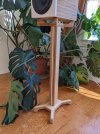Reminds me of the Heissmann Susie Q, just the driver and nice simple cabinet:

 heissmann-acoustics.de
heissmann-acoustics.de

Suzie "Q" | Scan-Speak Discovery compact speaker
Noble Scan-Speak loudspeaker at the “cheap trick” rate. Equipped with Discovery H2606 / 920000 and 22W / 4534G00.
 heissmann-acoustics.de
heissmann-acoustics.de











